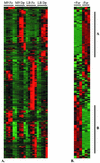Genomic profiling of iron-responsive genes in Salmonella enterica serovar typhimurium by high-throughput screening of a random promoter library
- PMID: 12897017
- PMCID: PMC166456
- DOI: 10.1128/JB.185.16.4973-4982.2003
Genomic profiling of iron-responsive genes in Salmonella enterica serovar typhimurium by high-throughput screening of a random promoter library
Abstract
The importance of iron to bacteria is shown by the presence of numerous iron-scavenging and transport systems and by many genes whose expression is tightly regulated by iron availability. We have taken a global approach to gene expression analysis of Salmonella enterica serovar Typhimurium in response to iron by combining efficient, high-throughput methods with sensitive, luminescent reporting of gene expression using a random promoter library. Real-time expression profiles of the library were generated under low- and high-iron conditions to identify iron-regulated promoters, including a number of previously identified genes. Our results indicate that approximately 7% of the genome may be regulated directly or indirectly by iron. Further analysis of these clones using a Fur titration assay revealed three separate classes of genes; two of these classes consist of Fur-regulated genes. A third class was Fur independent and included both negatively and positively iron-responsive genes. These may reflect new iron-dependent regulons. Iron-responsive genes included iron transporters, iron storage and mobility proteins, iron-containing proteins (redox proteins, oxidoreductases, and cytochromes), transcriptional regulators, and the energy transducer tonB. By identifying a wide variety of iron-responsive genes, we extend our understanding of the global effect of iron availability on gene expression in the bacterial cell.
Figures




References
-
- Ausubel, F. M., R. Brent, R. E. Kingston, D. D. Moore, J. G. Seidman, J. A. Smith, and K. Struhl (ed.). 1989. Current protocols in molecular biology. Greene Publishing Associates, New York, N.Y.
-
- Baumler, A. J., R. M. Tsolis, A. W. van der Velden, I. Stojiljkovic, S. Anic, and F. Heffron. 1996. Identification of a new iron regulated locus of Salmonella typhi. Gene 183:207-213. - PubMed
-
- Blattner, F. R., G. Plunkett III, C. A. Bloch, N. T. Perna, V. Burland, M. Riley, J. Collado-Vides, J. D. Glasner, C. K. Rode, G. F. Mayhew, J. Gregor, N. W. Davis, H. A. Kirkpatrick, M. A. Goeden, D. J. Rose, B. Mau, and Y. Shao. 1997. The complete genome sequence of Escherichia coli K-12. Science 277:1453-1474. - PubMed
Publication types
MeSH terms
Substances
LinkOut - more resources
Full Text Sources
Other Literature Sources
Medical

